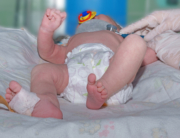 Hypoxic ischemic encephalopathy (HIE) is a brain dysfunction that can occur in babies during pregnancy, while the mother is in labor, or even during the delivery process.
Hypoxic ischemic encephalopathy (HIE) is a brain dysfunction that can occur in babies during pregnancy, while the mother is in labor, or even during the delivery process.
The name of the condition is made up of three parts:
- Hypoxic (meaning a lack of oxygen)
- Ischemic (meaning a restriction of blood flow)
- Encephalopathy (meaning a disorder of the brain)
In basic terms, HIE can occur when a baby’s brain does not receive an adequate amount oxygen for an extended period of time. This can lead to severe brain damage, as well as damage to other organs, like the heart, liver, kidneys, and bowels.
If your child has been diagnosed with HIE, it’s important that you understand all of the effects, complications, symptoms, and treatment options available, not to mention the legal options available to pay for losses and expenses related to the condition.
What causes HIE?
A lot of things can cause HIE, including:
- Uterine rupture
- Placental abruption
- Umbilical cord compression
- Maternal blood clotting disorders
- Low maternal blood pressure
- Cardiac arrest
- Severe trauma during delivery
Anything that cuts off the fetus’s supply of oxygen can cause the brain damage associated with HIE.
What are the symptoms of HIE?
Doctors may diagnose HIE by observing the child after birth and in some cases may order imaging tests to evaluate the brain. Below are just a few symptoms of HIE that babies afflicted with the condition may display:
- Abnormal movements or seizures
- Body seems “floppy” or they have problems feeding due to weak muscles in the mouth and throat
- Extremely unreactive to sights and sounds
- Overly tense and are more reactive than normal to stimulation
- Very weak cry
The extent to which the brain is damaged will affect the severity of HIE, so the symptoms and their severity varies from child to child.
What complications can HIE cause?
Since the severity of a child’s complications due to HIE are based on how much of their brain has been damaged, it may be difficult to say for sure what complications your child could face later in life.
However, here is a list of some of the most common problems facing children with HIE, according to HopeforHIE.org:
- Problems with too much or too little muscle tone
- Problems with coordination or fine motor skills
- Problems with feeding
- Learning disabilities
- Cerebral palsy
- Hearing disabilities
- Visual difficulties (such as cortical blindness)
- Seizures
Cerebral palsy is among the most common of these problems, as the damage associated with HIE may affect the areas of the brain that control muscle movement.
What treatment is available for HIE?
Doctors may use therapeutic hypothermia (or cooling) to reduce the risk of death and disabilities in babies born with HIE. Some studies have found that cooling the brain just a few degrees below normal body temperature can reduce the effects of brain damage. Some treatments use a cooling cap on the baby’s head, while others place the child on a cooling blanket. Doctors will monitor the child throughout the process.
Up to three babies out of every 1,000 born each year will be affected by HIE, according to HopeforHIE.org.. And the range of outcomes for how they will be affected when they are older is very wide and will affect any other treatment they require.
Some children are fortunate enough to grow up and have no lasting effects from HIE. Others however, will have to deal with mild to serious disabilities, depending on which areas of the brain were affected and to what degree. Sadly, death can even be a possibility if the condition is severe enough.
Filing A Legal Claim Against Medical Malpractice That Caused HIE
If your child was born with HIE due to medical malpractice, you may have grounds to file a legal claim against the doctor or hospital responsible. Of course, you can only do so if a doctor’s mistake caused your baby to be born with HIE. If this is the case, you could have the right to sue for damages.
To prove your medical malpractice claim there are several key factors you need to establish:
Standard of care: You must be able to establish what type of treatment or care the doctor should reasonably have given you and the child during labor and delivery.
Breach of standard of care: After you have demonstrated what actions your doctor should have taken under the circumstances, you must then provide proof that the doctor failed to meet those standards during your treatment. Proving standard of care and breach of standard of care may require testimony by an expert witness.
Causation: You must show evidence that the doctor’s negligent act caused your child’s condition (HIE, or otherwise).
Damages: You must also present evidence of the types of damages your child suffers because of the HIE, as well as present evidence that establishes the value of those damages.
If you are able to prove each of these factors, you may be able to sue for damages that include:
- Physical and mental pain and suffering
- Loss of enjoyment of life for your child
- Cost of medical bills for future treatments
Call Montero Law Center Now for A FREE Consultation
The attorneys at Montero Law have been helping medical malpractice victims in Fort Lauderdale and the surrounding areas for more than 30 years.
We are dedicated to doing whatever it takes to protect your rights and ensure you receive the quality of representation that you deserve. We’ll fight to make sure you are awarded fair compensation to deal with the emotional and financial hardships that come with having a baby born with HIE.
Call Montero Law Center or a free consultation. Call Montero Law Center today at 954-767-6500.
 English
English  Español
Español 

